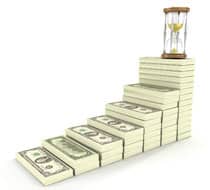by Mona Zemsky
If you don’t have an investment plan, you still may end up underfunding your retirement.
 |
By most measures, orthodontist Gordon Moffat, DDS, was a successful man. He grossed more than $1 million per year throughout the 1970s—a time when $1 million was still a lot of money. During more than 45 years in business, he operated multiple practices, stayed on the leading edge of his profession’s technology, implemented smart practice-management procedures and top efficiencies, and even taught others in his field.
Yet when heart problems forced Moffat into early retirement in 1998, he and his wife were left with just $1.5 million in assets (including their home). A brilliant orthodontist, good businessman, and great father, Moffat was, nonetheless, an utter failure at investing.
Decades of poor investment decisions whittled away a retirement nest egg that should have been worth $20 to $30 million. “His cash flow while working should have guaranteed ample funds for retirement,” says Clark Moffat, Gordon’s son. “Instead, he had to drastically reduce his lifestyle. It put him into a depression he never really recovered from. His kids didn’t have to pitch in completely, but what support he did have to take from us damaged his pride.”
 |
| Mona Zemsky |
The lesson other orthodontists should see in Gordon Moffat’s sad tale, Clark says, is that “being a good doctor—or even being a great businessman—does not necessarily mean you are a great investor.” The elder Moffat’s story isn’t unique, nor is it the product of a bygone era. Even today, with heightened awareness of the need to invest for retirement, thousands of hardworking, successful orthodontists are already on the same road Gordon Moffat traveled to retirement disaster.
Inspired by decades of watching his dad’s futile, unwise investments, Clark Moffat has built a career as a financial adviser specializing in counseling dental professionals. He is the founder of Vista, Calif-based Moffat Financial Group (moffatfinancialgroup.com), a boutique firm that uses synergistic planning to help dentists protect their retirements.
Dental professionals face a unique set of factors that create the potential for a poorly funded retirement, Moffat says. “You get just one class on practice management in dental school. School teaches you how to make money, but not what to do with it.” In many practices, and particularly among orthodontists, the high cash flow in relation to overhead can create a false sense of security. Plus, because orthodontics is less physically demanding than other disciplines, you may be able to work longer in your field than your peers. This longer working life may make you feel less urgency when it comes to financial planning and retirement preparation.
Five Worst Investing Mistakes
So what are the most common investing errors that orthodontists make? Moffat points to five:
1) Not Having a Plan
Certainly this mistake is common among all professionals, not just dental professionals. “You need to have a plan, and it should be specific, include a means to measure and monitor your results, and have a definitive time frame for achievement,” Moffat says. Without a plan, most high-earning professionals have a tendency to overspend, both in their business and personal lives, he says. For example, Moffat, who has been in financial planning for 28 years, recently took on a young orthodontist as a client. The man seems to be doing well, having been in his own practice for 2 years now. “But he’s running overhead of 80 to 85 percent,” Moffat says. “He has big goals, but no plan for how to get there.”
2) Forgetting That Economics Should Trump Taxes
“Dad’s investing philosophy was that even if it lost money, an investment was still good if it delivered tax benefits,” Moffat says. That thinking influenced the elder Moffat’s decision to invest in the largest privately owned dairy farm in Utah. (Co-investors included one very famous Mormon family: think show business, not politics.) “He also thought that my brother and I could work on the farm while we attended Brigham Young University,” Clark Moffat says. “Dad knew nothing about dairy farming, but was entranced by the tax benefits.” Ultimately, the farm failed, costing Moffat and other investors millions.
Overemphasis on taxes is, unfortunately, alive and well among orthodontists today. Moffat recently began advising a dentist who purchased his office building as a tax shelter, despite the fact that the sorry state of California real estate meant his investment immediately lost value and will likely continue to lose value over the next few years. The loss will exceed the tax benefits of ownership, Moffat points out.
“Managing your tax burden is a key part of your overall financial strategy,” he says. “But when it comes to investing, economics almost always trump taxes.”
3) Assuming You Can Always Make More Money
It’s easy for high-income professionals, especially those in the medical and legal fields, to assume they can always make more money if they need it. Because they’re doing well now, they assume they will always be doing well. This attitude can lead to overspending and a decreased sense of urgency regarding retirement savings. Moffat recalls his mother sometimes saying finances “were tight,” yet the family spent a month in Newport Beach every summer of his boyhood—a vacation that probably cost the equivalent of $30,000 to $35,000 in today’s money, not to mention the opportunity cost of the office being closed.
But hard work alone isn’t enough to ensure a solvent retirement. High-earning professionals need to remember that there will come a time when their earning ability may be curtailed, or even terminated, as in Gordon Moffat’s case. The economy, illness, injury, and a host of other factors may come into play, leaving you unable to maintain the earning level you currently enjoy.
“Dad thought he would practice until he died,” the younger Moffat says. “But when a heart attack forced him into retirement in 1998, he had to reduce his lifestyle. He died in 2004, a deflated man.”
4) Going It Alone/Taking Bad Advice
Freshly graduated with a degree in financial planning, Clark Moffat was visiting his father in his office one day when Gordon’s phone rang. It was a stockbroker in Laguna Beach with whom Gordon hadn’t spoken in 20 years. The man wanted Moffat to invest in a startup that sold fund-raisers to nonprofits. On the spot, Clark advised his father, who was just starting to recover financially from the dairy farm debacle, to pass, and the elder Moffat initially told the broker he wasn’t interested. “But the next day, the guy called back when I wasn’t there and Dad agreed,” Moffat says. “He lost about $2 million on that deal.
“He had an attorney, a son who was a financial planner, and two sons-in-law who were CPAs,” Moffat says of his father. “Yet he chose not to take any advice and instead made his own disastrous investing decisions.”
Making your own investment decisions, or basing your investments on what your peers are doing or on “advice” from poorly qualified sources, can cost you millions. It is well worth the expense of 1% or 2% to get good financial advice, Moffat says. And be sure to seek a planner who is interested in building a long-term relationship and not just in convincing you to drop a quick million on the pet investment opportunity of the moment.
5) Not Seeing the Big Picture
To be a successful investor, it’s vital to understand the nature of the economy. Your investment plan needs to be adaptable to meet the changing economic environment. Over the next decade, some 75 to 80 million Baby Boomers will retire, and their departure from the workforce will have a far-reaching impact on the economy, experts agree. Increased demands on the country’s Medicare, Medicaid, and Social Security systems may boost the tax burden on still-working Americans. What’s more, it’s likely that the Boomers will curtail their spending (since most will be on fixed incomes), further draining the economy. Moffat advises his clients to prepare for the coming shift in economy by thinking in terms of macro, not micro, investment strategies.
What’s on the Horizon
“Investors right now should be aware of the cycles our economy goes through and prepare themselves for the coming change of cycle,” Moffat says. “During any given 80-year time period, our economy goes through four economic cycles—we call them seasons of the economy—each typically lasting 10 or more years at a time: ‘growth boom,’ ‘shake-out,’ ‘maturity boom,’ and ‘inflationary downturn.’ We’ve been in a growth boom for the past 25 years, and we’re starting to see a turn toward the shake-out.”
During a shake-out, also called the “great winter” cycle, the economy slows. The American economy is driven by consumer spending. As more Baby Boomers retire and more working Americans face higher tax burdens, consumer spending will slow even more, further spurring the change of cycle. “How it will affect you depends on how nimble you are,” Moffat says. “Making strategic changes will be necessary for most investors.”
Moffat advises dentists to borrow a concept from farmers: “Knee high by the fourth of July.” For farmers, this means if the corn they planted in the spring is not “knee high” by Independence Day, they will not get a profitable crop out of it. In that case, they plow it under on July 5, and plant something else so that the entire growing season doesn’t go to waste and they minimize their economic losses.
Orthodontists should ask themselves some key questions when evaluating their investment plan’s ability to meet the changing economic environment:
- How will your practice be affected by a prolonged shake-out cycle?
- How will your personal and family financial goals be impacted?
- How will your investments do in this type of cycle?
“We know that in the next few years there will be an influx of patients who are reaching peak spending age for dental services, and fewer dentists to fill the needs of more patients. It may seem like an ideal scenario for increased profitability, but the exact opposite may actually be true,” Moffat says.
Routine checkups are linked to the economy, so as the economy begins to slow it’s likely more people will forego preventive care. Corporations, facing less revenue, will look to cut costs by reducing employee benefits like dental insurance. With fewer patients in the marketplace, price wars may occur between dental practices.
Preparing for the Future
So how can an orthodontist prepare his currently thriving practice to weather the economic storm? Moffat is cautious about providing “one size fits all” advice in an article such as this one, because personal circumstances, the geographic area, how far along the dentist is in his/her practice, and other factors will affect the recommendations. His assessments and recommendations are backed by, and always start with, a long-term economic forecasting technique based on the study of demographic trends and their impact on our economy. But trends never provide an absolute answer, only a good place to start evaluating an individual situation.
Clark Moffat did agree to share some specific tips he recently gave some midcareer orthodontists in Southern California:
- Immediately create a lean and efficient practice. Reduce payroll costs, pay off debt while cash flow is still strong, and keep a tight control on spending.
- If you own your building but don’t plan on keeping it for 20 years or more, sell it by 2011.
- If you are currently negotiating a lease, seek a short-term one that will expire in 2011 to 2012, then renegotiate a long-term lease at rates that will most likely be lower than today’s.
- If your lease will expire after 2011, consider negotiating a long-term lease at that time, since rates will likely be low.
- If you plan to retire in 5 or fewer years, consider retiring now by selling the practice before 2011.
- Educate your clients now on the cost-effectiveness of preventive dental care versus repairing problems or treating emergencies.
|
For a complete listing of companies that offer investment advice for orthodontists, click on “Personal Finance” in our online Buyer’s Guide. |
Finally, Moffat recommends that orthodontists should develop and implement a financial plan with the aid of a qualified adviser. Professional planners are trained to look at a client’s overall financial picture, from income and insurance to taxes and investing. “It’s often a challenge for people to find equilibrium among all those financial aspects on their own,” he says. “Think of a planner as your financial quarterback. Going it alone in terms of your investment strategy would be like one of your patients deciding to do his own root canal.”
Mona Zemsky is principal of MSource, a marketing strategy company that specializes in increasing exposure and results for small businesses. She has 20 years of experience providing hands-on marketing solutions, including 18 years as marketing manager for dental manufacturers Yates & Bird and Motloid. She can be reached at










